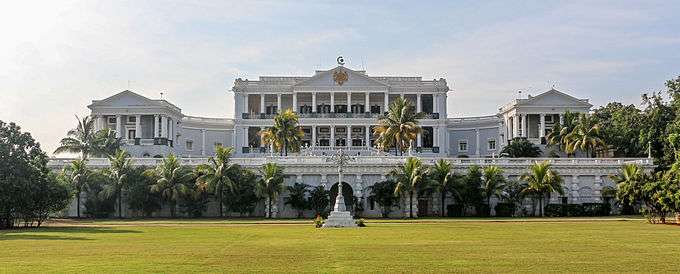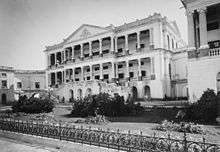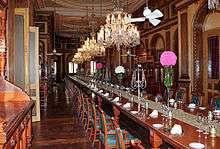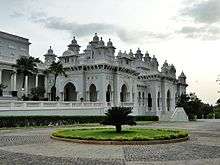Falaknuma Palace
| Falaknuma Palace ఫలకునుమా ప్యాలస్ فلک نما محل | |
|---|---|
 Falaknuma Palace northern view | |
| General information | |
| Architectural style | Andrea Palladio |
| Location | Hyderabad, India |
| Coordinates | 17°19′50″N 78°28′03″E / 17.3305°N 78.4675°E |
| Construction started | 3 March 1884 H.E. Nawab Sir Vicar ul Umra laid the foundation stone. |
| Completed | 1893 |
| Opening |
2010 (as a hotel) 1893 (as a palace) |
| Cost | 40 Lakhs |
| Owner | Nawab Sir Vikar ul Umra, Amir-e-Paigah (1884 to 1897) and later, The Nizam of Hyderabad |
| Management | Taj Hotels Resorts and Palaces |
| Technical details | |
| Size | 93,971 m2 (1,011,500 sq ft) |
| Design and construction | |
| Architect | William Ward Marrett.[1] |
Falaknuma is a palace in Hyderabad, Telangana, India. It belonged to the Paigah family, and it was later owned by the Nizam of Hyderabad.[2] It is on a 32-acre (13 ha) area in Falaknuma, 5 km from Charminar. It was built by Nawab Vikar-ul-Umra, prime minister of Hyderabad and the uncle and brother-in-law of the Nizam VI, Nawab Mir Mahboob Ali Khan Bahadur.[3] Falak-numa means "Like the Sky" or "Mirror of the Sky" in Urdu.
Design
An English architect designed this palace. The foundation stone for the construction was laid by Sir Vicar on 3 March 1884. He was the maternal grandson of H.H. Sikandar Jah Bahadur, Nizam lll of Hyderabad. It took nine years to complete the construction and furnish the palace. Sir Vicar moved into the Gol Bangla and Zanana Mahel of the Falaknuma Palace in December 1890 and closely monitored the finishing work at the Mardana portion. It is made completely with Italian marble and covers an area of 93,971 square meters.
The palace was built in the shape of a scorpion with two stings spread out as wings in the north. The middle part is occupied by the main building and the kitchen, Gol Bangla, Zenana Mehal, and harem quarters stretch to the south. The Nawab was an avid traveler, and his influences show in the architecture.
The Falaknuma palace is a rare blend of Italian and Tudor architecture. Its stained glass windows throw a spectrum of colour into the rooms.
History

Viqar-ul-Umra, the Prime Minister of Hyderabad, used the palace as his private residence until it changed owners and the palace was handed over to the 6th Nizam of Hyderabad around 1897-1898. Sir Viqar, besides being the prime minister of Hyderabad, was also the Amir-e-Paigah and was the maternal grandson of the Nizam III. He was married to Princess Jahandaar un-nisa Begum Sahiba also known as Lady Viqar ul Umra who was the daughter of H.H. Nawab Afzal Ul Dowla Bahadur, the Vth Nizam and elder sister of H.H. Nawab Mir Mehboob Ali Khan Bahadur, the VIth Nizam of Hyderabad.
The monogramme "VO" of H.E.Sir Viqar ul Oomra Bahadur is seen on the furniture, Walls and Ceiling of the palace.
Falaknuma Palace was built and furnished by Amir-e-Paigah Sir Viqar Ul Umra at a cost of forty Lakh rupees and it is said that even Sir Viqar whose estate and income was more than a 15 gun salute state had to borrow money from Bank of Bengal to complete his dream project (Paigah was referred to as a State within a State due to its sheer size, wealth and income). In the spring of 1897 Mehboob Ali Pasha Nizam VI was invited to the palace, the Nizam liked the palace so much that he decided to stay back as this was his elder sister Lady Viqar's residence. He extended his stay to a week then a fortnight and finally a month this prompted Sir Viqar to enquire if his sovereign liked the palace he would be honoured to offer it to him as Nazar (offering). The Nizam liked the gesture but, being the grand man that he was, it is said as per Royal family sources that he paid Sir Viqar a substantial sum. However the members of the Paigah family maintain that about 20 lakhs was paid by H.H. The Nizam and the rest was accepted as Nazar or Offering. The Nizam used the palace as a royal guest house as it had a commanding view of the entire city.
The Falaknuma fell silent after the 1950s. The last important guest was the President of India, Dr. Rajendra Prasad, in 1951. The palace was mostly kept closed since then and underwent a huge restoration after it was given on lease to the Taj Group of Hotels. The responsibility of the restoration to its original grandeur was led by H.H Princess Esra Jah, the first wife of H.E.H The VIlIth Nizam of Hyderabad.
The Palace

One of the highlights of the palace is the state reception room, where the ceiling is decorated with frescoes and gilded reliefs. The ballroom contains a two-ton manually operated organ said to be the only one of its kind in the world.
The palace has 60 lavishly decorated rooms and 22 spacious halls. It has some of the finest collections of the [4] treasure. Falaknuma houses a large collection of rare treasures including paintings, statues, furniture, manuscripts and books.
The jade collection at the palace is considered to be unique in the world.

The famed dining hall can seat 101 guests at its table, considered to be the largest in the world. The chairs are made of carved rosewood with green leather upholstery. The tableware was made of gold and crystal to which fluted music was added. The length of the table is 108 feet, and breadth is 5.7 feet and height is 2.7 feet.
The palace has a library with a carved walnut roof: a replica of the one at Windsor Castle. The library had one of the finest collections of the Quran in India.
The ground floor of the palace housed the living quarters. A marbled staircase leads to the upper floor. It has carved balustrades, which supports marble figurines with candelabra at intervals.
There is a billiards room. Burroughs and Watts from England designed two identical tables, one of which is in Buckingham Palace and the other in the Falaknuma Palace.[5]
On the walls of the landing are many oil paintings and photographs of notable personages.
The Falaknuma Palace also has the largest collection of Venetian chandeliers, with 40 138-arm Osler chandeliers in the halls.
The telephone and electrical system was introduced in 1883 by Osler and the palace has one of the largest electrical switchboards in India.
The palace was the private property of the Nizam family, and not normally open to the public, until 2000.
Renovation into a luxury hotel

In 2010, Taj Hotels started renovating and restoring the palace.[6] The renovated hotel was opened in November 2010.[7] The rooms and halls were decorated with ornate furniture, handcrafted tapestries and brocade from France. The interiors have English and Venetian chandeliers and intricate frescos, and have outdoor terraces with rare artefacts, including paintings, statues, furniture, manuscripts and books. The palace has a 101-seat dining hall, considered the largest in the world, and the Durbar Hall, embellished with intricately carved wooden ceilings, parquet flooring, walnut furniture and handcrafted mirrors.[8]
References
- ↑ "Falaknuma palace". Retrieved 3 March 2015.
- ↑ Business Standard. "Affairs of state". Business-standard.com. Retrieved 2012-12-20.
- ↑ "Falaknuma Palace".
- ↑ Nizam
- ↑ "Taj Falaknuma Palace review - One with the sky, one with royalty", The Hindu Business Line.
- ↑ "Ratan Tata to meet K Rosaiah on November 7 - Money - DNA". Dnaindia.com. 2010-10-31. Retrieved 2012-12-20.
- ↑ Cook, Sharell. "Falaknuma Palace Hyderabad Opens as a Luxury Taj Hotel". Retrieved 9 November 2010.
- ↑ "The Tribune, Chandigarh, India - Main News". Tribuneindia.com. Retrieved 2012-12-20.
External links
| Wikimedia Commons has media related to Falaknuma Palace. |
Coordinates: 17°19′51″N 78°28′03″E / 17.330955°N 78.467504°E